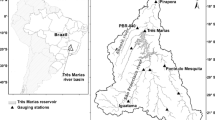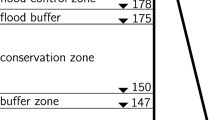Abstract
The paper focuses on the development of reservoir operating rules for dry and rainfall events, and their implementation in the case of the Ghézala dam located in northern Tunisia (characterized by Mediterranean climate). Rainfall events are defined in terms of depth and duration that are correlated to each other. A depth analysis per event is performed, conditioned on the event duration. The gamma distribution provides a good fit to depth per event, especially for events lasting at least 6 days. The event duration fits a geometric distribution, whereas the dry events during the rainy season fit a negative binomial distribution. The climatic cycle length is fitted to a gamma distribution. On this basis, many 50-year synthetic event series were generated. Every synthetic streamflow sequence obtained from synthetic rainfall sequences as well as the one derived from the historic rainfall events time series were optimized and optimal decisions were formulated. These decisions were assessed by means of multiple regression analysis to estimate the relation between the optimal decision to every stage (dry or rainfall event) and other system variables. Optimal rules, which have a linear form, were derived by predetermined useful storage interval and depend on storage, inflows and downstream demand at dry or rainfall event t. The range of t is 1–13 days (rainfall event) and 1–57 days (dry event). The rules were satisfactory for every predetermined useful storage interval. The simulated dam performance generated by the operation rules was compared with the deterministic optimum operation and the historical operation. Also included is the comparison of the implicit stochastic optimization-based operation policy per event during the water years 1985–2002.









Similar content being viewed by others
Notes
Failure to satisfy the irrigation water demands
References
Albergel J (1987) Genèse et prédétermination des crues au Burkina Faso. Du m2 au km2. Etude des paramètres hydrologiques et leur évolution. Thèse de Doct., Univ. De Paris VI, 336 p
Bellostas JM (1981) Cinquante modèles de recherche opérationnelle appliqués à la planification et à la gestion des ressources en eau. Document interne du laboratoire d’hydrologie mathématique, Montpellier
Bogardi JJ (1986) Event-based analysis of the dry spell phenomenon. In: Proceedings of international conference water Resource. Needs and planning in drought prone areas, Khartoum, Sudan, U.N. Dev. Program
Bogardi JJ, Duckstein L (1993) Evénements de période sèche en pays semi-aride. Revue des sciences de l’eau 6(1):23–44
Bogardi JJ, Duckstein L, Rumambo OH (1988) Practical generation of synthetic rainfall event time serie in semi-arid climatic zone. J Hydrol 103:357–373
Bouchart FJ-C (1996) Incorporating risk attitudes in an irrigation reservoir management model. Ph.D. dissertation. Central Queensland University, Rockhampton, Australia, 247 pp
Casenave A (1978) Etude hydrologique des bassins de Sanguéré. Cah. ORSTOM, Série Hydrol XV(1 et 2):3–209
Chevallier P (1983) L’indice des précipitations antérieures. Evaluation de l’humectation des sols des bassins versants représentatifs. Cah ORSTOM, Sér Hydrol XX(3 et 4):179–189
Esat V, Hall MJ (1994) Water resources system optimization using genetic algorithms. In: Verwey A, Minns AW, Babović V, Maksimović Č (eds) Proceedings of the first international conference on hydroinformatics (Delft, 1994). Balkema, Rotterdam, pp. 225–231
Fogel MM, Duckstein L (1982) Stochastic precipitation modelling for evaluating non-point source pollution in statistical analysis of rainfall and runoff. In: Proceeding of the international symposium on rainfall-runoff modelling, 1981: in statistical analysis of rainfall and runoff, pp 119–136. Water Resources Publications. Littleton
Hall WA (1964) Optimal design of a multipurpose reservoir. ASCE J Hydraul Div 90(HY4):141–149
Hall WA, Buras N (1961) Dynamic programming approach for water resources development. J Geophys Res 66(2):517–521
Karamouz M, Houck MH (1982) Annual and monthly reservoir operating rules generated by deterministic optimization. Water Resour Res 18(5):1337–1344
Kohler MA, et Linsley RK (1951) Predicting the runoff from strom rainfall. Weather Bureau, U. S. Dep. Of Commerce. Research Paper, no 34, Washington
Kularathna MDUP (1992) Application of dynamic programming for the analysis of complex water resources systems: a case study on the Mahaweli River Basin Development in Sri Lanka. Doctoral dissertation, Wageningen Agricultural University, Wageningen, The Netherlands, 163 p
Lafforgue A, et Casenave A (1980) Derniers résultats obtenus en zone tropicale sur les modalités de transfert pluie-débit par l’emploi de simulateurs de pluie. La Houille Blanche 4(5):243–250
Larson RE (1968) State incremental dynamic programming. Elsevier, New York, 256 p
Lavabre J (1980) Analyse de la pluviométrie du Réal Collobrier par la méthode des composantes principales. La Météorologie, VI e série 20–21:205–217
Molinier M (1981) Etude hydrologique des bassins de la Comba (République Populaire du Congo). Cah ORSTOM, Sér Hydrol XVIII(2–3):75–190
Oliveira R, Loucks DP (1997) Operating rules for multireservoir systems. Water Resour Res 33:839–852
Parent E, Lebdi F (1993) Bicriterion operation of a water resources system with reliability-based tradeoffs. Appl Math Comput 54(2–3):197–213
Saad M, Turgeon A, Bigras P, Duquette R (1994) Learning disaggregation technique for the operation of long-term hydroelectric power systems. Water Resour Res 30(11):3195–3202
Saad M, Bigras P, Turgeon A, Duquette R (1996) Fuzzy learning decomposition for the scheduling of hydroelectric power systems. Water Resour Res 32(1):179–186
Seguis L (1987) Indice des précipitations antérieures et prédiction des pluies au Sahel. Hydrol Continent 2(1):55–87
Shrestha BP, Duckstein L, Stakhiv EZ (1996) Fuzzy rule-based modelling of reservoir operation. J Water Resour Plann Manage 122(4):262–269
Yeh WW-G (1985) Reservoir management and operations models: a state-of-the-art review. Water Resour Res 21:1797–1818
Young GK (1966) Techniques for finding reservoir operation rules. Ph.D. thesis, Harvard University, Cambridge
Young GK (1967) Finding reservoir operation rules. ASCE J Hydraul Div 93(HY6):297–321
Author information
Authors and Affiliations
Corresponding author
Rights and permissions
About this article
Cite this article
Mathlouthi, M., Lebdi, F. Event in the case of a single reservoir: the Ghèzala dam in Northern Tunisia. Stoch Environ Res Risk Assess 22, 513–528 (2008). https://doi.org/10.1007/s00477-007-0169-3
Published:
Issue Date:
DOI: https://doi.org/10.1007/s00477-007-0169-3




